#three pagodas
Text
Nezha Fight Red Boy Three Times (1965) 哪吒三战红孩儿

Director: Kang Yi / Xiao Sheng
Screenwriter: Xiao Sheng
Country/Region of Production: Hong Kong, China
Language: Cantonese
Date: 1965-04-07
Also known as: The Adventures of Nazha / 哪宅三戲紅孩兒
Type: Retelling
Summary:
"Nezha Three Battles with Red Boy" is a movie directed by Xiao Sheng and starring Xiao Fangfang and Chen Baozhu.
Source: https://chinesemov.com/1965/The-Adventures-of-Nazha
Link: N/A
#Nezha Fight Red Boy Three Times#哪吒三战红孩儿#The Adventures of Nazha#哪宅三戲紅孩兒#Nezha#li nezha#jttw movie#movie#lost media#live action#retelling#addition#Red Boy#Princess Iron Fan#Lady Yin#Guanyin#Goddess of Mercy#Bull Demon King#Li Jing#Pagoda-Bearing Heavenly King#Snake Demon#Muzha
4 notes
·
View notes
Text
Will we ever get anything quite like Code Geass again?
I don't think it's possible.
Code Geass is Japanese nationalist propaganda disguised as a global political drama, disguised as a military mecha show, disguised as yaoibait, disguised as a teen melodrama, disguised as a high school romcom, disguised as a Pizza Hut commercial...
...except those layers aren't layers at all, but are instead comingled in a giant snake ball of insanity.
The lead writer, Ichirō Ōkouchi, only ever worked as an episode writer for other shows prior to Code Geass, and never took the helm of an anime series ever again. And it shows. [EDIT: Several people have pointed out his other lead writing credits to me. So I misread Wikipedia—sue me. I maintain that this guy is a better episode writer than he is a lead writer.]
The minute-to-minute pacing is impeccable from a mechanical standpoint, with tension and stakes rising to ever-higher peaks, balanced out by the slow simmers of the b-plot and c-plot. It keeps the viewer on the edge of their seat at all times. Meanwhile, the large-scale plot is the most off-the-wall middle school nonsense I've ever seen, continually surprising the viewer by pulling twists too dumb to have ever have been on their radar—and therefore more effective in terms of raw shock value.
"Greenlight it!" was the mantra of this anime's production. It must have been. It has, in no particular order, all of the following:
Character designs from CLAMP, the foremost yaoi/BL group in Japan at the time—for characters who are only queer insofar as they can bait the audience, and only straight insofar as they can be more misogynist to the female cast.
Speaking of the female cast, hoo boy the fanservice. We've all seen anime girls breast boobily, with many cases more egregious than Code Geass, but there's something special about it happening immediately after—or sometimes in the middle of!—scenes of military conflict and ethnic cleansing.
Pizza Hut product placement everywhere, in every conceivable situation. High-speed chases, light slice-of-life scenes, intimate character moments, all of it. Gotta have Pizza Hut.
The anime-only Pizza Hut mascot, Cheese-kun. He wears a fedora.
The most hilarious approximations of European names—which I would love to see more often, frankly. Names like, I dunno, "Count Schnitzelgrübe zi Blanquezzio."
A depiction of China that is wholly removed from any modern reality, with red-and-gold pagodas, ornamental robes, scheming eunuchs, and a brainwashed child empress. There's a character named General Tsao, like the chicken.
Inappropriate free-form jazz in the soundtrack, intruding at the most unexpected times.
A secret cabal not unlike the Illuminati, run by an immortal shota with magic powers, holding influence all across the world, at the highest levels of government. They matter for approximately three episodes.
An unexpected insert scene of a schoolgirl using the corner of a table to masturbate. She's doing it to thoughts of her crush, the princess Euphemia—because she believes Euphemia to be as racist as she herself is, and that gets her off. This interrupts an unrelated scene of our protagonist faction planning their next move, which then resumes as if uninterrupted.
Said schoolgirl, in a fit of hysteria, threatens to detonate a worse-than-nuclear bomb in the middle of her school. She then goes on to develop an even more destructive version of that bomb, and become a war criminal, in a chain of cause-and-effect stemming from the moment she finds out that Euphemia wasn't actually that racist.
A character called "the Earl of Pudding."
A premise that asks us to believe that the name Lelouch is normal enough that he didn't need to change it when he went into hiding as an ordinary civilian. "No, that's not Prince Strimbleford von Vanquish! That's our classmate, Strimbleford Smith."
The collective unconscious, a la Carl Jung, within which the protagonist fights his villainous father for control over the fate of humankind. After this is over, the anime just keeps going for about ten more episodes.
An episode in which a mech tosses a giant pizza.
A gay yandere sleeper agent who can manipulate the perception of time.
Chess being played very badly, even to the untrained eye. Lelouch frequently checkmates his opponent by moving his king. This goes hand-in-hand with the anime's crock of bad chess symbolism.
A fictional drug that can most succinctly be described as "nostalgia heroin."
Roller-skating mecha in knightly armor, and some of the most sickass mecha fight choreography that I've seen.
I could go on and on, but I think you get the picture. This anime is what the average Westerner in 2006 thought anime was, and it was made in a confluence of factors that cannot be replicated. I've never had so much fun watching something that I found so... insulting. Repugnant. Ridiculous. Baffling. I love it sincerely.
Catch me cosplaying Lloyd Asplund at a con sometime, or maybe even the big gay loser himself, Lelouch vi Britannia.
#code geass#anime#lelouch vi britannia#rolo lamperouge#nina einstein#kallen kozuki#lelouch lamperouge#clamp manga#lloyd asplund
4K notes
·
View notes
Text
The Inconsistency of Nezha's Age, a Short Introduction.
Put very bluntly, Nezha’s age varies greatly depending on which story you’re reading and who’s retold it. He is not always a child or an adult depending on retelling, though my intention here is to highlight the sheer variety available first and foremost - and perhaps shine a light on the Indian dieties which may have influenced him. If these varied images are unwanted, please keep scrolling.
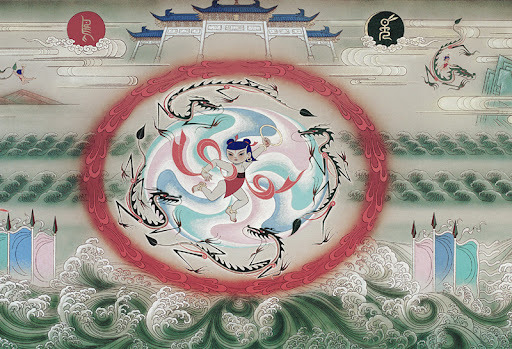
I happened to stumble upon a timeline error where Nezha’s brother Muzha is described to be using martial arts weapons referred to as “Hooks of Wu” which were specific to the 1800s, quite a long time after Canonization of the Gods was published, but also originating from a time period where numerous varied editions of that story were in circulation. Upwards of twenty different versions exclusive to the 19th century, actually.
The problem arises that Canonization of the Gods is meant to be occurring during the Zhou Shang conflict, that I will generously assume to be in 1045BCE, centuries before the Hooks of Wu would actually exist. It’s completely possible that the version Gu Zhizhong translated was one of these later editions as is makes no chronological sense for Muzha to have those kinds of weapons to begin with. So I have been on somewhat of a rabbit chase trying to pin down the edition Gu Zhizhong used.
Bearing such errors in mind, it’s easy to see where the confusion of Nezha’s age can come from. Before his origin story was integrated within Canonization of the Gods he would be roughly three to seven days old when his conflict with Ao Guang and the Lady Rock Demoness would occur - whereas within Canonization of the Gods he’s actually 6 or 7 years old.
Outside of that, a definitive age isn’t actually provided. Genuinely, within the scope of Chinese folklore and mythos it’s very rare to assign someone an exact age - which I do believe contributed heavily to the known discourse surrounding Nezha’s age to begin with.
He was imported as an adult from India, a child form not seeming to exist for a while until stories of Krsna were integrated to how the Chinese envisioned Nalakubara. Krsna, being an infantile disguise for the notorious Vishnu, also displays supernatural human strength and is actually successful in killing his father figure (1) — unlike Nezha.
As children, both Krsna and Nezha are able to wield heavenly bows and subjugate water spirits (2) while also being known to be dragon tamers (3). The inclusion of these stories to Nezha predates the sculpting of the Quanzhou Pagoda’s (which have been discussed briefly here) and are arguably the earliest evidence of Nezha being a dragon tamer.
Speculatively a child god combination of both Nalakubara and Krsna named Nana is likely where a majority of Nezha’s child attributes come from, based in the Scripture of the Supreme Secrets of Nana Deva - which would see translations within China during the Northern Song period of 960AD-1127AD. Nana would be described thus:
At that time there was a Deva called Nana. His appearance was exceptionally handsome, and his face beamed with a gentle smile. He was holding the sun, the moon, and various weapons. His numerous treasures and abundant jewelry shone more brightly than the sun and the moon. He made himself a luoye robe (4) from the dragons Nanda and Upananda, and a belt from the dragon Taksaka (5). He possessed the same strength as Narayana (i.e. Visnu). He too came to the assembly and sat down facing the Buddha … At that time the Buddha emanated great light from his dharma body of meditation. The light covered the entire Buddha Universe, reaching all the great evil yaksas, the various types of raksasas and pisacas (6) and all the evil dragons as far as the heavenly constellations. When the Buddhas light shone upon them they all awoke to the truth. The Buddhas light returned to him and, after encircling him three times, entered his head. It then reissued in seven colors from his brow, entering Nana-Deva’s head. When the Buddha light penetrated his head, Nana Deva displayed an enormous body like Mt. Sumeru. His facial expression alternated between terrifying anger and a broad smile. He had a thousand arms, and he was holding a skull (7) and numerous weapons. He was handsomely adorned with a tiger skin robe and skulls. [Mightily Strong] He emanated blazing light and terrifying strength. When Nana Deva displayed this divine body, the great earth shook, and all who beheld him were terrified.
Both Nana and Nezha share the same residence of Vaisravana’s palace, are known dragon tamers, and both were known to use belts. The Supreme Secrets of Nana Deva predate all known connections between Nezha and dragons, perhaps lending to Nezha many more elements than initially believed.
Though without concrete evidence stating one way or another, I can only present this information speculatively - especially as it seems difficult for some to understand that Nezha does enjoy a known adult and child form. This answer has already become quite long, so if there’s still confusion regarding this please feel free to ask for more details.
Bibliography:
(1) Goldman, “Fathers, Sons and Gurus,” pp.350, 364; Masson, “Childhood of Krsna”; Ramanujan, “The Indian ‘Oedipus’”; Silk, Riven by Lust, pp. 164-170.
(2) Harley, “Krishna’s Cosmic Victories”; Matchett, “Taming of Kaliya”.
(3) It’s worth comparing Matchett’s “Taming of Kaliya” p.116 with Canonization of the Gods 12.103. Nezha is five days old within the Ming era Sanjiao yuanliu shengdi fozu sou shen daquan, p. 326.
(4) Luoye is the Chinese term for a garment Indian men tied under the armpit, leaving their right shoulder bare. See Xuanzang, Da Tang Xiyu ji, T. 2087, 51: 876b, and Li Rongxi’s translation, Great Tang Dynasty Record, p.53.
(5) Nanda, Upananda, and Taksaka appear in various Buddhist lists of the eight dragon kings; see Foguang da cidian, pp. 6378,6405.
(6) The rakasas and pisacas are two types of Hindu ogres, who Buddhists demonology incorporated. Both types feed on human flesh. See Foguang da cidian, pp6673-6674 and 3851; Monier-Williams, A Sanskrit-English dictionary, pp. 871 and 628; and Strickman’s survey of Buddhist demonology in his Chinese Magical Medicine, pp. 62-68.
(7) Geboluo appears frequently within the contemporaneous Chinese translation of the Hevajra Tantra (Foshuo dabeikong zhi jin’guang dajiaowang yigui jing), no. 892 volume 18: 587-601.
(8) Zuishang mimi Nana tian jing, no. 1288, 21:358b-c. hi
#nezha#li nezha#lmk nezha#monkie kid nezha#the legend of nezha#nezha 2019#nezha reborn#nezha lego monkie kid#third lotus prince#lego monkie kid
171 notes
·
View notes
Text

I want to talk about the stripes I make.
According to a book, there are 270 names for striped patterns in Japanese. Thousand stripes (sen-suji), ten-thousand stripes (man-suji), with kids stripes (komochi-jiima), twin stripes (futago-suji), fall stripes (taki-jima), bonito stripes (katsuo-jima), benkei stripes (benkei-jima), wickerwork stripes (ajiro-jima), etc., etc., etc.
Among these, I basically make random stripes, called “yatara-jima”.
Yatara-jima have no regularity in the arrangement of the stripes, and were originally woven to finish off the threads left over from weaving, and originated mainly for women's kimono.
Yes, weaving always produces surplus threads, but that does not mean that a regular number of threads can be taken.
If that were the case, it would be more fashionable to arrange them randomly... nowadays, but I think it's amazing that the people who first made them ( I suspect that they were everywhere in private kimonos) and put them on the market are so amazing.
I think there were people who thought it was interesting and stylish... but I wonder through what channels it spread. I wonder if it was a marketing strategy at the time to have ukiyo-e paintings of beautiful women drawn, or if the models happened to be wearing them. It’s similar to influencer marketing or buzzing on SNSs!? I can imagine all sorts of things.
Taking these cloths as an example, I used 19 different threads in total: three red, three yellow, five green, three grey, three purple, one off-white and one non-dyed white.
In my case, I of course use leftover thread, but basically, as in normal weaving, I have a design first and then prepare the thread. To be more precise, I have the design, dye the necessary colours, take some yarns out of the chest, lay them out, look at the colours and readjust the design. I use two or three threads of the same colour to create shading or variation in the slightly thicker stripes.
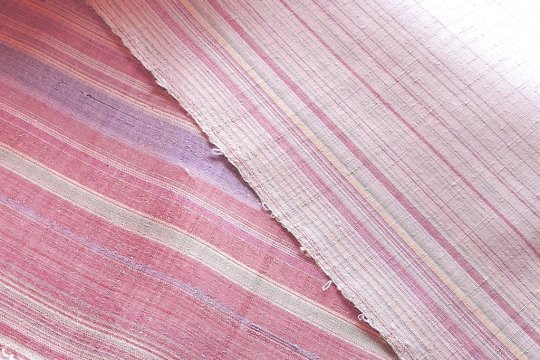
But sometimes I feel that I have made a mistake, because when I add the weft yarn, there is not much difference, and in some cases it is a newly dyed yarn, and I feel like, "Wow, give me back my time!" Sometimes I feel like, “Wow, I want my time back!” I'm not experienced enough …
It is actually very difficult to distinguish between the two types of red cloth.

It's not so much about making stripes, but more about the colour composition of the kimono or the shape of the cloth, so it may be a slightly different way of making it.
The right two madders look different, but...
-------
I used the same warp (silk) as this cloth and hand-spun ramie yarn as the weft, and of the 19 colours... 15 are included.
Red: Indian Madder (strong&pale), Sappanwood
Yellow: Amur Corktree (strong&pale), Gardenia
Green: Ōbaku x odour wood (two light varieties), Green leaf extract powder, Japanese Pagoda Tree x Indigo (strong&pale)
Grey: Cochineal (strong&pale), Sawtooth Oak
Purple: Cochineal, Lithospermum Erythrorhizon (strong&pale)
Off-white: Walnut
264 notes
·
View notes
Text
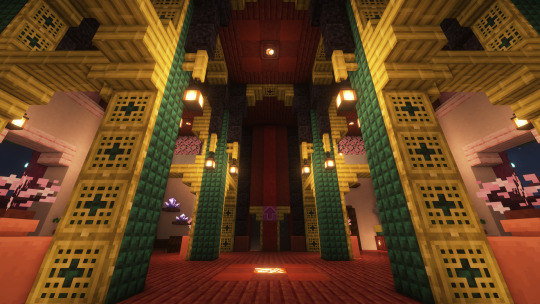


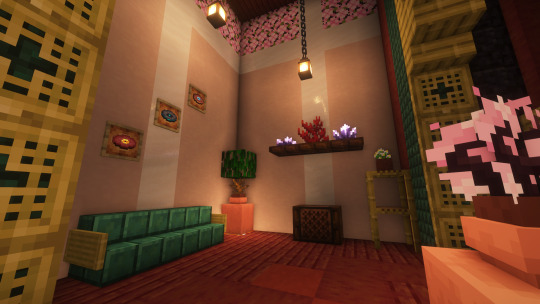

Tier three of my pagoda, featuring a bedroom, storage room, music room, and conservatory.
62 notes
·
View notes
Text
Mysterious Lotus Casebook timeline
I put this together for my own use while writing my fic, but haven't seen anyone else share one, so here goes!
This is live-drama canon, not novel canon. I don't speak much Chinese; I followed iqiyi's subtitles which are rather awful. Additions/suggestions/comments/corrections more than welcome!
As should be expected for a comprehensive timeline of all pre-canon events, this is not spoiler free. Below the cut, as it's long:
Timeline
130 years ago:
Princess Longxuan is born, in the year of Ren Yin, Wu Shen month, Geng Jia day, at the hour of Geng Chen. [It could be any year of Ren Yin, but since it has to be more than a hundred years ago, this one is the only one that makes sense.]
100 years ago:
The night before Nanyin was overturned, Princess Longxuan marries Crown Prince Fangji, the eldest son of Emperor Xicheng, granduncle of the current emperor. Princess Longxuan becomes Consort Xuan. Consort Xuan secretly initiates the revival of Nanyin and plots to use the Rama Vessel.
Prince Fangji conspires against Emperor Xicheng and fails. He is ordered to commit suicide. Consort Xuan is sentenced to be buried with Prince Fangji.
Princess Longxuan writes a letter to magician Feng A-Lu asking him to save her son at the bamboo forest. She tells him to contact Jin Yu Huang Quan and revive Nanyin.
Nanyin craftsmen build their tomb and Nanyin sorcery hides it for 100 years.
The throne passes to Emperor Guanqing.
Feng A-Lu does not meet Princess Longxuan's son. He goes to kill the imperial family and falls in love with Consort Ying instead. They have a son who Consort Ying passes off as the emperor's son. Feng A-Lu is buried in the collapse of the Pagoda of Bliss.
Jin Yu Huang Quan did not revive Nanyin. They used the amassed wealth for themselves and passed the Rama ices onto the next generations.
Unknown time:
Li Xiangyi's parents save Qi Mushan.
Bandits attack the Li family; Li Xiangyi and his older brother are the only survivors.
25 years ago:
Teenage Shan Gudao finds four-year old Li Xiangyi and his older brother on the streets. Older brother dies.
Qi Mushan rescues Shan Gudao and Li Xiangyi and brings them to Yunyin mountain.
20 years ago:
The Feng clan, having searched for Princess Longxuan's descendant for over a hundred years, learns that her grandson had a ten-year-old son who is presently studying under Qi Mushan.
[Note Shan Gudao is over twenty and Li Xiangyi is nine or ten at this time, but anyway:]
The Feng clan takes Shan Gudao as the long-lost descendant of Princess Longxuan.
Ostensibly 18 years ago, but probably more like 21 or 20:
[Note there is some debate about how old Fang Duobing is supposed to be. Di Feisheng claims he has a letter showing that Fang Duobing's parents broke up 18 years ago while He Xialan was pregnant, but other sources state he is 20 at the time of the show]
He Xialan was in a relationship with Shan Gudao. They break up while she is pregnant. Fang Duobing is born a few months later, and Tianji Hall announces Xialan has died of illness. Fang Duobing is raised by Xialan's older sister and her husband as their own.
15 years ago:
The Demon of the Blood Realm challenges Li Xiangyi and Qiao Wanmian begs him to give Li Xiangyi one more year.
14 years ago:
Li Xiangyi passes Qi Mushan's test. He receives the Shaoshi sword. He departs the mountain for the first time.
Shan Gudao and Li Xiangyi go to rescue the He family of the Changma Blade sect, who was massacred by Dongling Three Gang for the cloud iron. They find one survivor, a child, and take him to Louyang. Shan Gudao ditches Li Xiangyi and kills the kid.
Li Xiangyi defeats the Demon of the Blood Realm.
At an unknown time between 15 and 10 years ago:
Di Feisheng, Wuyan, King Bai of Fire, Four-faced Qingzun, and King Zunming of Yama found the Jinyuan alliance. Di Feisheng makes his first famous kill: the Monk of the Blood Realm, Kuang Jiezi. He removes the Golden Jade hoops from his staff and hangs them on his dao as a trophy.
Li Xiangyi fights with Wuyou and nicks the Shaoshi sword to avoid killing him.
The 12 Guardians join the Jinyuan alliance just before Jiao Liqiao does.
Jiao Liqiao was following Li Xiangyi around. A girl from Fengling Sword Sect provoked Jiao Liqiao and she massacres the Fengling Sword sect. Li Xiangyi stops her and attempts to kill her, but Di Feisheng saves Jiao Liqiao.
13 years ago:
Li Xiangyi establishes the Sigu Sect. Sigu sect makes an agreement with the court dividing the affairs of the people and the affairs of the jianghu. Everyone agrees to follow the legal code of Da Xi.
Scholar Sushou robs the imperial mausoleum in the south of the capital.
Di Feisheng rescues Jiao Liqiao from a gang led by Guishou Fenglie, whose martial arts techniques she tried to steal. Di Feisheng was just there to challenge the gang leader for his spot on the martial arts rankings.
12 or 11 years ago:
Just before Li Xiangyi turns 18, Shan Gudao gives him the Wenjing sword as a birthday present.
At the age of 18, Li Xiangyi acquires Yangzhouman.
11 years ago:
Sigu sect destroys the cult in Mobei and the sect's vitality is damaged. The Jinyuan alliance becomes more powerful. Di Feisheng and Li Xiangyi make a peace treaty: they won't interfere with each other or draw a war in five years.
The royal court agrees to ally with Shan Gudao.
Ten years ago:
[Depending on how old you think Fang Duobing is; he says this happened when he was ten] Madam He introduces Shan Gudao to Fang Duobing as her long-lost brother. Shan Gudao teaches Fang Duobing martial arts in secret before he can walk. Fang Duobing briefly meets Li Xiangyi, who gives him a wooden sword.
Li Xiangyi trespasses into the Royal Palace grounds on Mid-Autumn night to watch the Epiphyllum festival.
Lian Quan, Lord Of The Netherworld, is last seen in Shishou Village.
Shan Gudao tries to break into the Yipin tomb but cannot get past the Bagua (eight trigrams) Formation. The 14 Thieves of the Netherworld break into the tomb and die inside.
Li Xiangyi receives a message that the three kings of the Jinyuan alliance have besieged Shan Gudao in the Yangsha valley, the Jinyuan alliance's secret hideout. Meanwhile, the three kings receive a challenge from Shan Gudao but the letter was not his handwriting. The three kings arrive at the valley to find Shan Gudao already dead. Other members of the Sigu sect claim: they followed Shan Gudao to run some errands but were suddenly attacked by the three kings; Shan Gudao sent someone to go for help; Shan Gudao lured the three kings away to protect his subordinates.
Li Xiangyi cradles his shixiong's body and vows revenge. Shan Gudao's body is stolen in an ambush by the Jinyuan alliance. Li Xiangyi declares war on the Jinyuan alliance.
Li Xiangyi gathers Shan Gudao's belongings into a box in his room at the Sigu sect headquarters.
Yun Biqiu, at Jiao Liqiao's direction, administers Bicha poison to Li Xiangyi.
Jiao Liqiao and Fang Qing are working together. Someone from Nanyin purchases gunpowder from Thunder Hall in Jiangnan with funds from the Wansheng clan. Ding Yun, Wind and Thunder Emissary and Wan Renshan, Star and Moon Emissary used thundering fire bombs to trap the Sigu Sect and blow up the Jinyuan alliance headquarters. The 12 guardians of the Jinyuan alliance die. 58 heroes of the Sigu sect die.
27th day of the 12th lunar month, year of Xin Chou: Li Xiangyi and Di Feisheng battle at the East Sea.
Someone alters a corpse to look like Shan Gudao. He survives, under the influence of wuxin huai. Shan Gudao kills Qi Mushan and takes his inner power.
Li Xiangyi fakes his death and disappears. The Sigu sect disbands. Its surviving arm, Baichuan Court, rounds up the remnants of the Jinyuan alliance. Di Feisheng goes into seclusion for ten years.
Ten or nine years ago:
Xin Lie, Thunder Chaser of Jinyuan alliance, Five Poison Palm, escapes from prison.
28th day of the 5th month, year of Ren Yin: Shi Hun writes a letter to the Sigu sect to thank them for releasing him.
Unknown, between ten years ago and present day:
The Jinyuan Alliance surrounds Lian Quan's mansion for the Rama Heavenly Ice, he escapes with Li Xiao and Li Xiong to Xiaoyuan City to live in hiding.
Li Lianhua finds Scholar Sushou, helps him and lets him stay with him. Scholar Sushou passes away.
Li Lianhua saves Tiexiao, who jumped off a cliff and was buried; Li Lianhua heard him shouting.
Four-faced Qingzun dies in prison and gives the Rama ice shard to his wife, Liangyi Xianzi.
Fang Duobing takes bitter medicine; bathes in cold springs; pierces his 12 major acupoints every day and faints many times but refuses to cry. He can stand up, walk, and learn martial arts.
Five years ago:
The Hall of Wind and Flame took the Shi family's secret book as their own. This includes Qi Mushan's recipes.
Three years ago:
Fang Duobing takes the Baichuan Court entrance examination, but they refuse to accept him.
One year ago:
"Last March": Li Lianhua saved Shi Wenjue, third son of the Shi family (he faked his suicide because he wanted a career in public service and his family didn't approve, Li Lianhua saw it). The Shi family in Weapons Valley were the ones who forged Cloud Iron armor and the wind sword.
Present day:
The show begins sometime after the sixth day of the fourth month of Ren Zi year. [We know this because in episode 2, Wangfu is sixteen and we are given his birthday as April 6th of Bing Shen Year]
Red Mountains (Girls' Mansion episode arc) takes place on month 9 day 9 of Ren Zi Year.
Episode 37/38 is the ten-year anniversary of the dong hai duel, so it takes place on the 27th day of 12th month of Ren Zi Year.
60 notes
·
View notes
Text

Les Modes : revue mensuelle illustrée des arts décoratifs appliqués à la femme, no. 4, avril 1901, Paris. Mlle Gilda Darthy. Cliché Boyer. Robe de Ville. Modèle Laferrière. Cliché Reutlinger. Bibliothèque nationale de France
Page 16. — ROBE DE PROMENADE (Mademoiselle Gilda Darthy). — Robe en drap clair. — Corsage drapé de côté et retenu par un motif de passementerie. La manche forme pagode, avec dépassant à petits plis en mousseline de soie ou linon blanc. La jupe à petits plis cousus.
Page 20. — ROBE DE VILLE (Modèle Laferrière). — Jupe de mousseline de soie avec application de Cluny noir et blanc, le bas incrusté de voile bleu; longue double jupe en voile bleu, voilant toute la robe, relevée très légèrement par trois plis à la taille. — Corsage de voile bleu, voilant également un corsage en mousseline de soie, avec incrustations comme pour la jupe. Manches de voile bleu avec incrustations au coude et formant un sabot de voile bleu plissé avec une application. Ceinture de velours noir avec un gros nœud derrière.
—
Page 16. — PROMENADE DRESS (Miss Gilda Darthy). — Dress in light cloth. — Bodice draped sideways and held in place by a trimmings pattern. The pagoda-shaped sleeve, with small pleats in white silk muslin or lawn. The skirt with small sewn pleats.
Page 20. — CITY DRESS (Laferrière Model). — Silk chiffon skirt with black and white Cluny application, the bottom inlaid with blue veil; long double skirt in blue veil, veiling the entire dress, raised very slightly by three pleats at the waist. — Blue veil bodice, also veiling a silk muslin bodice, with inlays as for the skirt. Blue veil sleeves with inlays at the elbow and forming a pleated blue veil shoe with an application. Black velvet belt with a large bow behind.
#Les Modes#20th century#1900s#1901#periodical#fashion#fashion plate#photograph#bibliothèque nationale de france#dress#Modèles de chez#Mademoiselle Gilda Darthy#Maison Laferrière#one color plates
35 notes
·
View notes
Text

THE ROTHSCHILD CHINOISERIE NECESSAIRE
A GEORGE III JEWELLED GOLD AND HARDSTONE NECESSAIRE AND WATCH
The rectangular upright casket set with panels of banded grey agate, overlaid with chased foliate and architectural gold cagework, applied with silver and gold-mounted vari-colour diamond and ruby-set floral sprays and emerald-set foliage, the double pagoda cover chased with foliage, flowers, scale and diaper-work and applied with alternating rows of diamonds, emeralds and rubies, each corner hung with pendant single stones, the hinged top of the pagoda cover opening to reveal a fitted interior containing various gold implements including, a bodkin, a cotton spool, an ear-spoon, a pen, a burin and a brush, the front door of the base inset with a fitted mirror and opening to reveal a red velvet-lined fitted interior with two rock-crystal scent-bottles overlaid with gold cagework, a gold cup with applied chinoiserie decoration and scroll handle, marked with maker's mark AH probably for Andrew Hogg, two gold sablé drawers chased with chinoiserie landscapes containing a gold ink-well and powder-box, the gold base on four bracket feet and mounted with diamond and emerald-set chased scrolling cartouches, with original gold door key, in later fitted black leather travelling case stamped ‘Bulgari’
Diamonds: 374 stones, approx. 31 cts.
Rubies: 109 stones, approx. 14 cts.
Emeralds: 125 stones, approx. 9 cts.
The Watch: White enamel with Roman and Arabic numerals, with winding aperture at 10 o’clock, pierced gold hands, the watch movement gilt-brass, full-plate with cylindrical pillars, fusee with chain, verge escapement, plain brass three-arm balance with flat spring and regulator, gilt brass cock, signed ‘Robert Allam London, No 396’
Christie’s
69 notes
·
View notes
Text
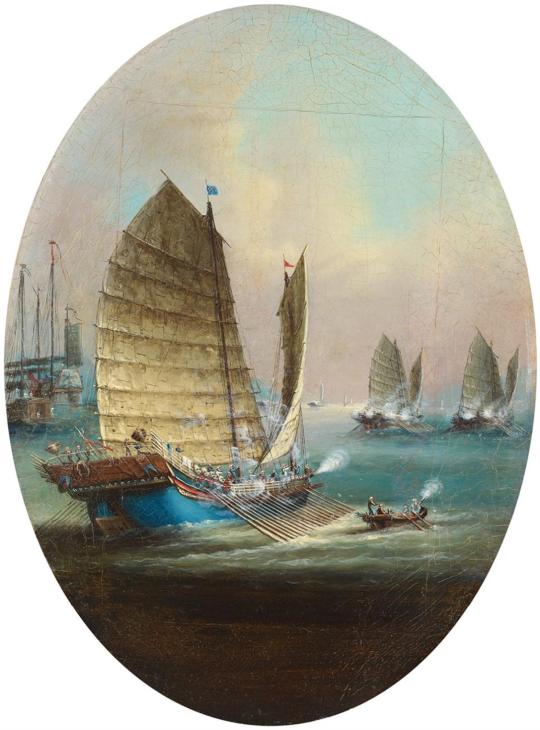

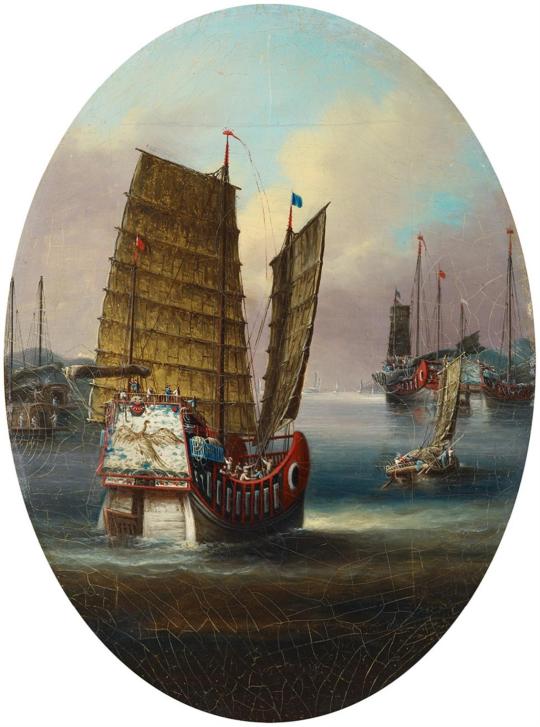

Four navigation scenes on the Yuejiang near Canton. By Yougua, 1840
a) Three junks in manoeuvre; b) Ningpo junk together with passenger junks in front of Whampoa Pagoda; c) Ningpo junk; d) River passenger junk in front of Dahuangjiao Fortress.
60 notes
·
View notes
Text
The Crow's Nest Chan Master of JTTW
I am reading back through Journey to the West (Xiyouji, 西遊記) and was reminded of a strange, seemingly throwaway character who appears at the end of chapter 19, the "Crow's Nest Chan Master" (Wuchao chanshi, 烏巢禪師). He is described as an accomplished cultivator who lives in a juniper tree nest on Pagoda Mountain (Futu shan, 浮屠山), just beyond the border of Tibet (Wusicang, 烏斯藏). Zhu Bajie claims the master once asked him to jointly practice austerities, but the pig-spirit passed on the opportunity. Flash back to the present, and the pilgrims pass into his domain. After a brief chat, the Crow's Nest Chan master orally passes on the Heart Sutra (Xin jing, 心經) to Tripitaka.
There are two things that interest me about the Chan Master. The first is his magical abilities. Sun Wukong is offended by the monk but fails to hit him with his staff:
Enraged, Pilgrim lifted his iron rod and thrust it upward violently, but garlands of blooming lotus flowers were seen together with a thousand-layered shield of auspicious clouds. Though Pilgrim might have the strength to overturn rivers and seas, he could not catch hold of even one strand of the crow's nest (Wu & Yu, 2012, vol. 1, p. 391).
This reminds me of an event from Acts of the Buddha (Sk: Buddhacarita; Ch: Fo suoxing za, 佛所行讚, 2nd-century), an ancient biography of the Buddha:
The host of Mara hastening, as arranged, each one exerting his utmost force, taking each other’s place in turns, threatening every moment to destroy [the Buddha, but] … Their flying spears, lances, and javelins, stuck fast in space, refusing to descend; the angry thunderdrops and mighty hail, with these, were changed into five-colour’d lotus flowers…” (Beal, 1883, pp. 152 and 153).
This points to the Crow's Nest Chan Master having great holy powers.
The second thing that interests me is that he is based on a historical monk, Niaoke Daolin (鳥窠道林, lit: "Bird's Nest" Daolin; 741–824). Here is his full biography from the Records of the Transmission of the Lamp (Jingde chuandenglu, 景德傳燈錄, 1004 to 1007):
Chan master Niaoke Daolin ... was from Fuyang in Hangzhou and his family name was Pan. His mother, whose maiden name was Zhu, once dreamt of the rays of the sun entering her mouth, after which she conceived. When the baby was born a strange fragrance pervaded the room, so the name ‘Fragrant Light’ was given to the boy. He left the home life at the age of nine and received the full precepts at the Guoyuan Temple in Jing (Jingling, Hubei) when he was twenty-one years old. Later he went to the Ximing Monastery in Chang’an to study the Huayan Jing (Avatasaka Sūtra) and the Śāstra on the Arising of Faith (Śraddhotpada Śāstra, Aśvagosa) under the Dharma Teacher Fuli, who also introduced him to the Song of the Real and Unreal, and had him practise meditation.
Once Niaoke asked Fuli, ‘Could you say how one meditates and
how to exercise the heart?’
Teacher Fuli was silent for a long time, so then the master bowed
three times and withdrew.
It happened that at this time Tang Emperor Taizong had called the
First Teacher in the Empire [Daoqin] of Jing Mountain to the Imperial Palace and Daolin went to pay him a formal visit, obtaining the True Dharma from him.
Returning south the master first came to the Yongfu Temple on
Mount Gu (Zhejiang), where there was a stūpa dedicated to the
Pratyekabuddhas. At this time both monks and laymen were
gathering there for a Dharma-talk. The master also entered the hall, carrying his walking stick, which emitted a clicking sound. There was a Dharma-teacher present from a temple called Lingying, whose name was Taoguang, and who asked the master, ‘Why make such a sound in this Dharma-meeting?’
‘Without making a sound who would know that it was a Dharmameeting?’ replied the master.
Later, on Qinwang Mountain, the master saw an old pine tree
with lush foliage, its branches shaped like a lid, so he settled himself there, in the tree, which is why the people of that time called him Chan Master Niaoke (Bird’s Nest). Then magpies made their nest by the master’s side and became quite tame through the intimacy with a human – so he was also referred to as the Magpie Nest Monk.
One day the master’s attendant Huitong suddenly wished to take
his leave. ‘Where are you off to then?’ asked the master.
‘Huitong left the home life for the sake of the Dharma, but the
venerable monk has not let fall one word of instruction, so now it’s a question of going here and there to study the Buddha-dharma,’
replied Huitong.
‘If it could be said that there is Buddha-dharma,’ said the master, ‘I also have a little here,’ whereupon he plucked a hair from the robe he was wearing and blew it away. Suddenly Huitong understood the deep meaning.
During the Yuan reign period (806-820 CE) Bai Juyi was
appointed governor of this commandery and so went to the
mountain to pay the master a courtesy call. He asked the master, ‘Is not the Chan Master’s residing here very dangerous?’
‘Is not your Excellency’s position even more so?’ countered the
master.
‘Your humble student’s place is to keep the peace along the
waterways and in the mountains. What danger is there in that?’
asked Bai Juyi.
‘When wood and fire meet there is ignition – the nature of thinking
is endless,’ replied the master, ‘so how can there not be danger?’
‘What is the essence of the Buddha-dharma?’ asked Bai.
‘To refrain from all evil and do all that is good,’ answered the
master.
‘A three-year-old child already knows these words,’ said Bai.
‘Although a three-year-old can say them, an old man of eighty
can’t put them into practice!’ countered the master.
Bai then made obeisance.
In the fourth year, during the tenth day of the second month of the reign period Changqing (824 CE), the master said to his attendant, ‘Now my time is up.’ And having spoken he sat on his cushion and passed away. He was eighty-four years old and had been a monk for sixty-three years.
(Textual note: Some say the master’s name was Yuanxiu, but this
is probably his posthumous name.) (Whitfiled, n.d., pp. 56-58).
Sources:
Beal, S. (Trans.). (1883). The Fo-sho-hing-tsan-king: A Life of Buddha by Asvaghosha Bodhisattva. Oxford: Clarendon Press. Retrieved from https://archive.org/details/foshohingtsankin00asva/mode/2up.
Whitfiled, R. S. (Trans.). (n.d.). Records of the Transmission of the Lamp: Volume 2 - The Early Masters. Hokun Trust. Retrieved from https://terebess.hu/zen/mesterek/Lamp2.pdf
Wu, C., & Yu, A. C. (2012). The Journey to the West (Vols. 1-4) (Rev. ed.). Chicago, Illinois: University of Chicago Press.
#Journey to the West#JTTW#Sun Wukong#Monkey King#Tripitaka#Tang Monk#Tang Sanzang#Xuanzang#Zhu Bajie#Pigsy#Crow's Nest Chan Master#JTTW characters
31 notes
·
View notes
Text


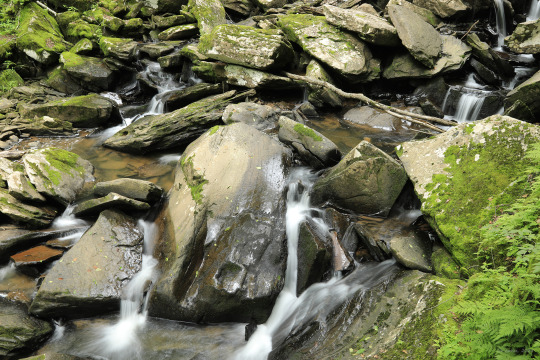
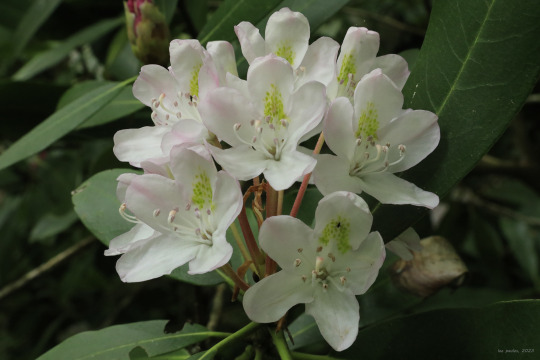


Falls of Hills Creek Scenic Area, a short detour off the Highland Scenic Highway in the Monongahela National Forest. The scenic area includes three beautiful waterfalls on Hills Creek, the lowest of which (top photo) is the second highest waterfall in West Virginia.
From top: the lower falls, which is 63 feet high; the middle falls, which is 45 feet high; great rhododendron (Rhododendron maximum) in bloom; a ravine hillside overspilling with ferns, hairy wood mint (Blephilia hirsuta), and wild hydrangea (Hydrangea arborescens); a gorgeous hairy wood mint, whose stacked, fragrant flower garlands lead to its other common name - hairy pagoda plant.
#appalachia#vandalia#west virginia#wildflowers#allegheny mountains#monongahela national forest#summer#wv route 150#falls of hills creek scenic area#falls of hills creek#highland scenic highway#great rhododendron#hairy wood mint#flora#wild hydrangea#smooth hydrangea
79 notes
·
View notes
Text
Journey to the West Chapter 5
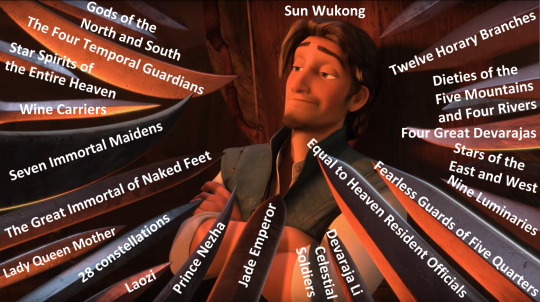
I think Sun Wukong might have made a few people mad this chapter of Journey to the West with @journeythroughjourneytothewest
So this chapter, Sun Wukong managed to gain another three levels to his immortality stat with the good old, tried and true method of stealing.
First up, we got the Peaches of Immortality, which the Jade Emperor had put him in charge of in order to give him something to do so he wouldn't get bored. And Sun Wukong took to sending the staff away from the garden so he could nap and eat the peaches unimpeded. I also get to add a slightly new crime to his rap list for this one since this is his place of employment: Employee Theft.
We also get a case of False Imprisonment, when Sun Wukong immobilizes the Seven Immortal Maidens who come to collect peaches for the peach festival.
Next up, for his second gained level of immortality we got the Heavenly Wine. Where Sun Wukong gains yet another new crime for his rap sheet, Impersonating a Government Official, when he runs into the Great Immortal Naked Feet, and sends him to the Hall of Perfect Light for a 'rehearsal' so Sun Wukong can take his place. So Sun Wukong makes his way to where the Banquet is being held and his attention is grabbed by the smell of wine. In order to try some, Sun Wukong uses magic to put the wine carriers to sleep.
For his third level of immortality, Sun Wukong realizes that he'll probably get in trouble for stealing the Heavenly Wine and tries to go home, but instead drunkenly wanders into Laozi's lab. Where he spots some pills of immortality. Which he of course immediately eats- which while making him now five times immortal also sobers him up.
Now that he's sobered up, he decides to head home to Flower Fruit Mountain to avoid the consequences. The monsters of Flower Fruit Mountain are ecstatic to see him again, especially since he's been gone for over a century now since he spent a half year in heaven this time. He gladly tells them everything that happen, but finds that he no longer has a taste for regular food after having grown accustomed to divine food and wine. So Sun Wukong sneaks his way back into heaven to steal some more wine to share with everyone. Making some of his monkey's doubly immortal at this point.
Meanwhile, word has gotten back to the Jade Emperor about Sun Wukong's exploits so he sends what seems to be the entire heavenly army out to arrest him. And so the battle between Heaven's army and Sun Wukong and his demon army begins!
Sun Wukong manages to personally beat the Nine Luminaries and then sends out his army to help him battle the Four Great Devarajas and Twenty Eight Constellations. Most of his army is captured, his four commanders and monkey troop all manage to escape. Meanwhile Sun Wukong manages to beat back The Four Great Devarajas, Li the Pagoda Bearer, and prince Nezha with some duplicates.
Current Sun Wukong Stats:
Names/Titles: Monkey, The Stone Monkey, The Handsome Monkey King, Sun Wukong (Monkey awakened to the void), and The Great Sage Equal To Heaven.
Immortality: 5
Weapon: The Compliant Golden Hooped Rod
Abilities: 72 Transformations, Cloud-Somersault, Ability to transform his individual hairs, super strength, Ability to Summon Wind, Water restriction charm, and the ability to change into a huge war form, ability to duplicate his staff, ability to immobilize others, and the ability to put others to sleep.
Demon Kill Count: 1+ Unknown Number of Minions
God's Defeated: 17
Crime List: Robbery, Murder, Mass Murder, Arson, Theft, Coercion, Threatening a Government Official, Resisting Arrest, Assault, Forgery, Employee Theft, False Imprisonment, and Impersonating a Government Official.
Cry Count: 2
92 notes
·
View notes
Note
I understand that there are many versions of Nezha and we shouldn't stick to just one version, but I wanted to ask, does Nezha's age vary in any of the stories?
Hello!
Put very bluntly, yes, Nezha’s age varies depending on which story you’re reading and who’s retold it.
I happened to stumble upon a timeline error where Nezha’s brother Muzha is described to be using martial arts weapons referred to as “Hooks of Wu” which were specific to the 1800s, quite a long time after Canonization of the Gods was published, but also originating from a time period where numerous varied editions of that story were in circulation. Upwards of twenty different versions exclusive to the 19th century, actually.
The problem arises that Canonization of the Gods is meant to be occurring during the Zhou Shang conflict, that I will generously assume to be in 1045BCE, centuries before the Hooks of Wu would actually exist. It’s completely possible that the version Gu Zhizhong translated was one of these later editions as is makes no chronological sense for Muzha to have those kinds of weapons to begin with. So I have been on somewhat of a rabbit chase trying to pin down the edition Gu Zhizhong used.
Bearing such errors in mind, it’s easy to see where the confusion of Nezha’s age can come from. Before his origin story was integrated within Canonization of the Gods he would be roughly three to seven days old when his conflict with Ao Guang and the Lady Rock Demoness would occur - whereas within Canonization of the Gods he’s actually 6 or 7 years old.
Outside of that, a definitive age isn’t actually provided. Genuinely, within the scope of Chinese folklore and mythos it’s very rare to assign someone an exact age - which I do believe contributed heavily to the known discourse surrounding Nezha’s age to begin with.
He was imported as an adult from India, a child form not seeming to exist for a while until stories of Krsna were integrated to how the Chinese envisioned Nalakubara. Krsna, being an infantile disguise for the notorious Vishnu, also displays supernatural human strength and is actually successful in killing his father figure (1) — unlike Nezha.
As children, both Krsna and Nezha are able to wield heavenly bows and subjugate water spirits (2) while also being known to be dragon tamers (3). The inclusion of these stories to Nezha predates the sculpting of the Quanzhou Pagoda’s (which have been discussed briefly here) and are arguably the earliest evidence of Nezha being a dragon tamer.
Speculatively a child god combination of both Nalakubara and Krsna named Nana is likely where a majority of Nezha’s child attributes come from, based in the Scripture of the Supreme Secrets of Nana Deva - which would see translations within China during the Northern Song period of 960AD-1127AD. Nana would be described thus:
At that time there was a Deva called Nana. His appearance was exceptionally handsome, and his face beamed with a gentle smile. He was holding the sun, the moon, and various weapons. His numerous treasures and abundant jewelry shone more brightly than the sun and the moon. He made himself a luoye robe (4) from the dragons Nanda and Upananda, and a belt from the dragon Taksaka (5). He possessed the same strength as Narayana (i.e. Visnu). He too came to the assembly and sat down facing the Buddha … At that time the Buddha emanated great light from his dharma body of meditation. The light covered the entire Buddha Universe, reaching all the great evil yaksas, the various types of raksasas and pisacas (6) and all the evil dragons as far as the heavenly constellations. When the Buddhas light shone upon them they all awoke to the truth. The Buddhas light returned to him and, after encircling him three times, entered his head. It then reissued in seven colors from his brow, entering Nana-Deva’s head. When the Buddha light penetrated his head, Nana Deva displayed an enormous body like Mt. Sumeru. His facial expression alternated between terrifying anger and a broad smile. He had a thousand arms, and he was holding a skull (7) and numerous weapons. He was handsomely adorned with a tiger skin robe and skulls. [Mightily Strong] He emanated blazing light and terrifying strength. When Nana Deva displayed this divine body, the great earth shook, and all who beheld him were terrified.
Both Nana and Nezha share the same residence of Vaisravana’s palace, are known dragon tamers, and both were known to use belts. The Supreme Secrets of Nana Deva predate all known connections between Nezha and dragons, perhaps lending to Nezha many more elements than initially believed.
Though without concrete evidence stating one way or another, I can only present this information speculatively - especially as it seems difficult for some to understand that Nezha does enjoy a known adult and child form. This answer has already become quite long, so if there’s still confusion regarding this please feel free to ask for more details.
Bibliography:
(1) Goldman, “Fathers, Sons and Gurus,” pp.350, 364; Masson, “Childhood of Krsna”; Ramanujan, “The Indian ‘Oedipus’”; Silk, Riven by Lust, pp. 164-170.
(2) Harley, “Krishna’s Cosmic Victories”; Matchett, “Taming of Kaliya”.
(3) It’s worth comparing Matchett’s “Taming of Kaliya” p.116 with Canonization of the Gods 12.103. Nezha is five days old within the Ming era Sanjiao yuanliu shengdi fozu sou shen daquan, p. 326.
(4) Luoye is the Chinese term for a garment Indian men tied under the armpit, leaving their right shoulder bare. See Xuanzang, Da Tang Xiyu ji, T. 2087, 51: 876b, and Li Rongxi’s translation, Great Tang Dynasty Record, p.53.
(5) Nanda, Upananda, and Taksaka appear in various Buddhist lists of the eight dragon kings; see Foguang da cidian, pp. 6378,6405.
(6) The rakasas and pisacas are two types of Hindu ogres, who Buddhists demonology incorporated. Both types feed on human flesh. See Foguang da cidian, pp6673-6674 and 3851; Monier-Williams, A Sanskrit-English dictionary, pp. 871 and 628; and Strickman’s survey of Buddhist demonology in his Chinese Magical Medicine, pp. 62-68.
(7) Geboluo appears frequently within the contemporaneous Chinese translation of the Hevajra Tantra (Foshuo dabeikong zhi jin’guang dajiaowang yigui jing), no. 892 volume 18: 587-601.
(8) Zuishang mimi Nana tian jing, no. 1288, 21:358b-c. hi
#nezha#li nezha#lmk nezha#monkie kid nezha#nezha 2019#the legend of nezha#nezha lego monkie kid#third lotus prince#nalakubara#krsna#vishnu#nana deva
41 notes
·
View notes
Text
More SaShiSu headcanons because I'm crazy and suffering from extreme brain rot. 🥴

At every Goodwill event they've joined in... The unspoken rule is: Don't mess with Shoko. Mess with Shoko, you either risk getting blasted across the forest or plagued by pesky curses.
SaShiSu has definitely tried their hand out at knitting or cross-stitching at some point. It was part of Yaga's lesson plan at the beginning of the school year.
10 years later, Satoru has a mountain of arcade tickets he has yet to exchange. Tickets won by the 3 of them. He can never do it anymore because it's been a decade and the arcade they used to go to is now closed. 😔
SaShiSu played hide-and-seek once or twice.
➼ Gojo always won because he cheated. He has Six Eyes and he can teleport. He leaves his hiding spot whenever Suguru or Shoko get close.
➼ Suguru and Shoko definitely know. The third time they played, Suguru just left behind a bunch of traps made of curses to annoy him. It hardly worked, and one of them got Yaga accidentally.
➼ End result: SaShiSu at detention.
SaShiSu used to watch Digimon reruns on the weekend mornings. Gojo begged them once and it turned into their thing.
SaShiSu played a lot of Mario. Suguru insisted.
Shoko secretly played the Sims 2 and made Suguru and Satoru in-game. She made them do questionable things. Sim Satoru was abducted and impregnated by aliens at some point.
SaShiSu played a three-way Yu-Gi-Oh Duel Monsters game once.
➼ Satoru's deck is a mix-match and he kept bragging that he had all 3 Blue Eyes White Dragons. (Let's be honest, he just copied Kaiba's deck from Battle City).
➼ Shoko took out a chunk of Suguru's and Satoru's life points with a potent spellcaster-deck.
➼ They stopped playing because Satoru realized that Suguru put together an Exodia-themed deck and all that time, Suguru bided his time and kept drawing cards and discarding them to the graveyard, so he could eventually collect all 5 pieces of Exodia.
➼ They wish they had duel disks though.
They definitely went hunting for Duel Disks at kids' toy stores around Tokyo at Shoko's insistence. Satoru and Suguru indulge her.
SaShiSu played a lot of board games and other card games too.
➼ They put together a money pool. Winner takes all.
➼ For some reason, Suguru liked the randomness of Chutes & Ladders. He also has a thing for Chess. Satoru doesn't have the patience for chess. Suguru's also good at Checkers and Backgammon.
➼ Shoko wins at Uno, Poker, and Scrabble.
➼ Satoru is a monster at Monopoly. They use Satoru's real money in Monopoly btw, because rich boy doesn't mind squandering his parents' finances on the games they'd play 💴. He ends up buying more than half of the properties on the board in every game. Capitalist whore.
SaShiSu definitely played with a Ouija board more than once.
➼ It doesn't work inside campus... because Tengen's barrier, so Satoru and Suguru always find the most gnarly and "haunted" places around the city to fuck around with the Ouija board.
➼ They bring Shoko with them.
➼ Ouija board sessions always end in fits of giggles, Satoru making fun of the curses or vengeful spirits they'd attract or summon, Suguru eating the curses that were hostile, and Shoko being amused at the utter ridiculousness of the situation.
➼ One or two spirits actually willingly left after being summoned because even in death, no one wants to deal with a teenage Satoru Gojo.
On that note, Satoru definitely found paranormal games on the internet and tried them out with Suguru and Shoko.
They may or may not have lit fireworks inside abandoned warehouses in an attempt to exorcise the curse through noise pollution. Why? Eh, just because. Most of the time, you don't need a reason do to shit when you're young and you feel like you're on top of the world. Naïve little shits. Shoko is the only sensible one istg.
Satoru stole a removable stone statue in Jujutsu Tech once after Suguru jokingly dared him to do it.
➼ He hid it in one of the decoy pagodas around the school.
➼ He runs over to tell Suguru like, "SUGURU SUGURU SUGURU, I did the dare!"
➼ And Suguru is like, "WTF?"
➼ Needless to say, they got in trouble for it because they told Shoko and didn't see Yaga hanging around close by. Idiots... 🙄😁
#jujutsu kaisen#sashisu#headcanons#jjk#jjk s2#jjk season 2#i love this trio so much#satoru gojo#gojo satoru#suguru geto#geto suguru#shoko ieiri#ieiri shoko#wbad blog#wbad shit posts
89 notes
·
View notes
Text
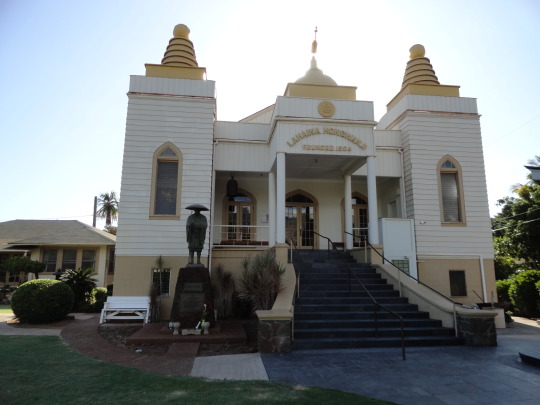
A terrible day for Hawaii and the Buddhist community. The wild fire killed dozens of people and destroyed Lahaina, including the historic and beloved Lahaina Hongwanji Mission (Jodo Shinshu, founded in 1904), Lahaina Jodo Mission (Jodo Shu, founded in 1912), and Lahaina Hokoji Shingon Mission (Shingon Shu, founded in 1902). These three temples have been central places of community, refuge, culture, and support for generations of Japanese Americans and others. The Shingon temple was the first outside of Asia. The Jodo one featured a three-story pagoda (rare outside of Asia) and replica of the famous Amida Daibutsu of Kamakura. The Jodo Shinshu temple sangha is especially large and active for the area, with over 70 member families. Information about how to support the Lahaina Buddhist community in the midst of this tragedy will be forthcoming.

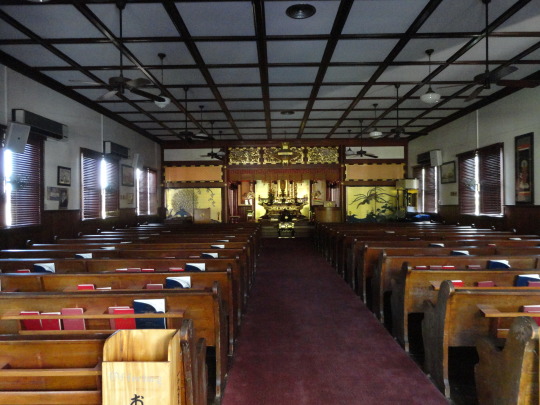


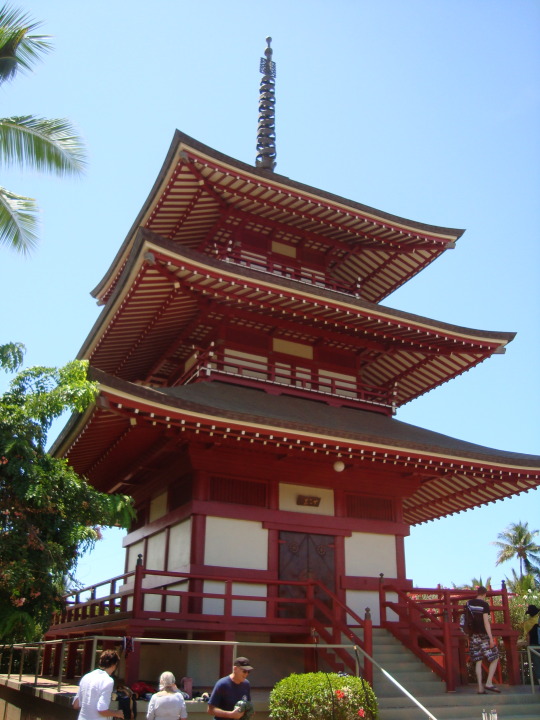



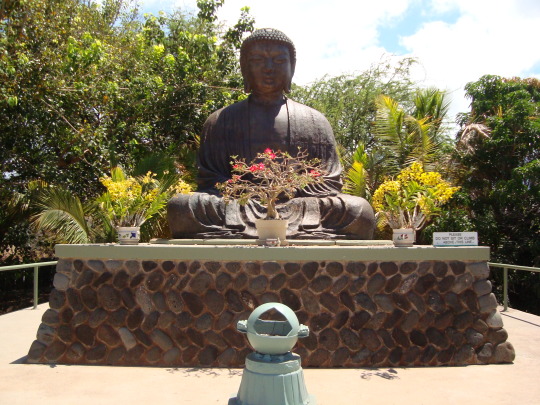
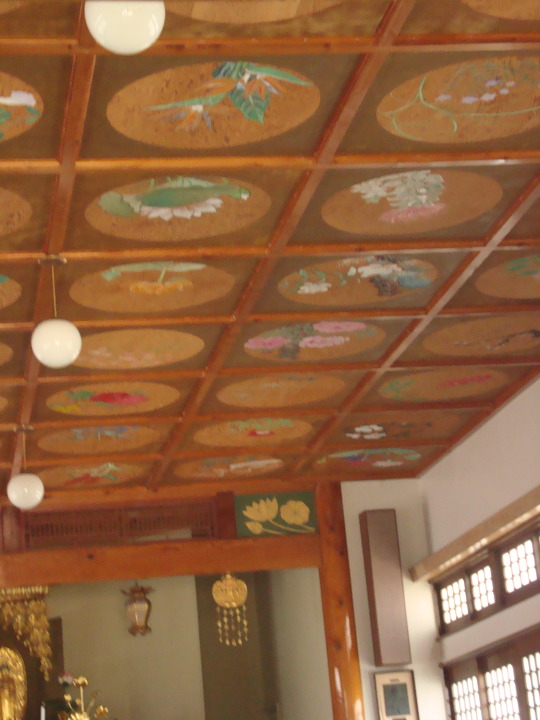

77 notes
·
View notes
Text
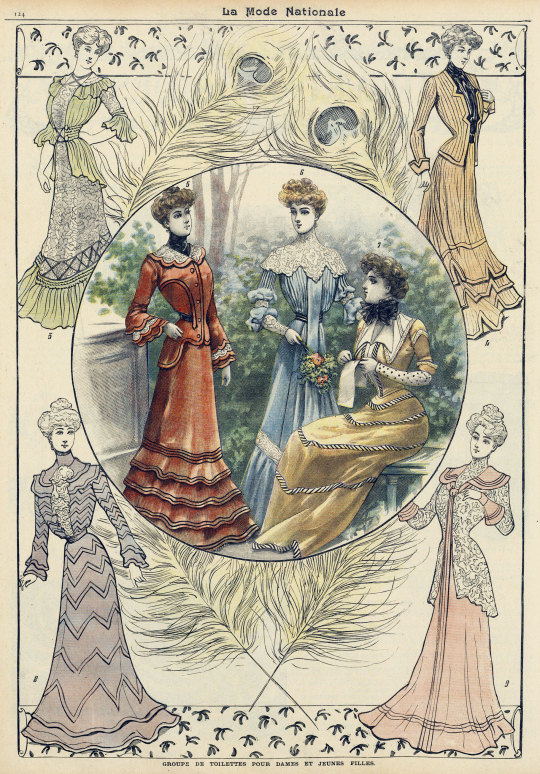
La Mode nationale, no. 16, 19 avril 1902, Paris. Groupe de toilettes pour dames et jeunes filles. Bibliothèque nationale de France
(3) Robe de dîner pour jeune femme. Jupe en dentelle sur transparent blanc, bordée d'un volant bouillonné en liberty vert d'eau ou en crêpe de Chine. Au-dessus du volant, croisillons de velours noir.
Veste bouillonnée à la taille et formant basque mi-longue, ouverte sur un dessous de dentelle et rattachée devant par des velours croisés, avec de gros boutons fantaisie. Col fichu en mousseline de soie, souligné d'un volant froncé. Manche courte en dentelle, avec grand volant bouillonné.
(3) Dinner dress for a young woman. Lace skirt on white sheer, edged with a bubbled ruffle in water green liberty or crepe de chine. Above the ruffle, black velvet braces.
Jacket gathered at the waist and forming a mid-length peplum, open to a lace underside and attached in front with crossed velvets, with large fancy buttons. Silk chiffon kerchief collar, highlighted with a gathered ruffle. Short lace sleeve, with large bubbled ruffle.
Matériaux: dentelle en laize; 8 mètres de liberty.
—
(4) Robe de ville pour jeune femme ou dame d'âge moyen, en lainage rayé abricot, de ton effacé. Jupe plissée derrière terminée par trois volants en forme, découpés en créneaux et bordés de biais. Au volant supérieur, un biais souligne la tête. Jaquette ouverte et découpée sur un plastron de liberty noir. Manche à coude, revers assez large.
(4) City dress for young women or middle-aged ladies, in apricot striped wool, in a faded tone. Pleated skirt at the back finished with three shaped ruffles, cut into crenellations and edged at an angle. On the upper ruffle, a bias highlights the head. Dust jacket open and cut on a black liberty bib. Elbow sleeve, fairly wide lapel.
Matériaux: 8 mètres de lainage, 0m,75 de liberty noir.
—
(5) Toilette de visites pour jeune femme, en foulard rouge glacé. Jupe en forme; au bas, quatre volants légèrement badinés, soulignés de comètes de satin noir et surmontés de quatre rangs de comètes. Jaquette dentelée devant, bordée de biais à dépassant noir. Un biais semblable s'arrondit par des pinces en arrière. Ceinture de satin noir passant sous les devants. Col arrondi incrusté de guipure. Guimpe de soie noire. Manche pagode à pèlerines dentelées; celle du milieu est semblable au col.
(5) Visiting ensemble for young woman, in iced red scarf. Skirt shaped; at the bottom, four slightly embellished ruffles, highlighted with black satin comets and topped with four rows of comets. Serrated dust jacket in front, bias-edged with black protruding. A similar bias is rounded by darts at the back. Black satin belt passing under the front. Rounded collar inlaid with guipure. Black silk wimple. Pagoda handle with serrated capes; the middle one is similar to the collar.
Matériaux: 14 mètres de foulard.
—
(6) Robe élégante pour jeune fille ou jeune femme, en bengaline bleu-pastel. Jupe plissée devant, ornée d'un volant en forme que surmonte un large entre-deux. Corsage plissé; col empiècement en guipure; sous ce col commence un pli genre Watteau qui s'évase sur la jupe. Manche plissée sur l'épaule et séparée en deux bouffants par un bracelet de guipure. Poignet haut et collant en guipure. Ceinture ronde en taffetas blanc, rayé de velours noir.
(6) Elegant dress for a young girl or young woman, in pastel blue bengaline. Pleated skirt at the front, decorated with a shaped flounce topped with a wide in-between. Pleated bodice; guipure yoke collar; under this collar begins a Watteau-style pleat which flares out on the skirt. Pleated sleeve on the shoulder and separated into two bouffants by a guipure bracelet. High, sticky guipure cuff. Round belt in white taffeta, striped with black velvet.
Matériaux: 12 mètres de bengaline.
—
(7) Robe de visites pour jeune femme ou dame d'âge moyen en drap satin chamois. Jupe en forme cerclée de biais en taffetas pékiné. Boléro très ajusté, ouvert sur un gilet de drap blanc à revers. Grand col de moire, rayé et bordé d'entre-deux. Cravate de mousseline de soie noire. Manche courte à petits revers.
Bas de manche collant en soie blanche moucheté de noir.
(7) Visiting dress for young or middle-aged ladies in chamois satin cloth. Bias-rimmed skirt in pekiné taffeta. Very fitted bolero, open over a white cloth vest with cuffs. Large moire collar, striped and bordered with insertions. Black chiffon tie. Short sleeve with small cuffs.
Fitted cuffs in white silk speckled with black.
Matériaux: 5 mètres de drap; 1 mètre de soie mouchetée; 0m,30 de drap blanc; 0m,50 de moire.
—
(8) Robe de visites pour jeune femme, en lainage fantaisie vieux rose. Jupe en forme, cerclée de biais posés en dents de soie et tombant sur un volant en forme liséré de biais. Même garniture au corsage et à la manche demi-pagode. Devant, coquillé de dentelle; au col montant, liséré de liberty noir; ceinture ronde en l'étoffe de la robe.
(8) Visiting dress for young women, in fancy old pink wool. Shaped skirt, surrounded by bias placed in silk teeth and falling on a shaped ruffle edged at an angle. Same trim on the bodice and half-pagoda sleeve. Front, shell of lace; with a high collar, lined with black liberty; round belt made from the fabric of the dress.
Matériaux: 7m,50 de lainage.
—
(9) Toilette de réception pour jeune femme ou dame d'âge moyen, en surah vieux rouge très pâle. Plis cerclant la jupe. Veste Louis XV en grosse dentelle. Plastron et manche de dentelle. La manche se termine sous un revers arrondi orné de plis. Col arrondi en forme. Echarpe de mousseline de soie, même ton, nouée sous le col et tombant jusqu'au bas de la robe.
(9) Reception ensemble for young or middle-aged lady, in very pale old red surah. Pleats encircling the skirt. Louis XV jacket in large lace. Lace bib and sleeve. The sleeve ends under a rounded lapel decorated with pleats. Rounded shaped collar. Silk chiffon scarf, same tone, tied under the collar and falling to the bottom of the dress.
Matériaux: 10 mètres de surah; dentelle en laize; 4 mètres de mousseline de soie.
#La Mode nationale#20th century#1900s#1902#on this day#April 19#periodical#fashion#fashion plate#color#description#bibliothèque nationale de france#dress#collar
19 notes
·
View notes